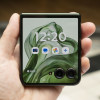MWC 2010
We had a chance to play with the two new Garmin-Asus Nuvifone devices the Android-toting A50 and the Windows Mobile 6.5.3-totaing M10. Neither of these will make it the U.S., but they are interesting nonetheless in how Garmin-Asus has chosen to customize each platform. Here's our take.
A50
This handset is much better than the original nuvifone announced two years ago. it has a nice, bright, colorful screen that looks sharp. The overall feel of the device is solid. It's lightweight, feels good in the hands, and is obviously customized to sit sideways in a Garmin-Asus cradle.
There's a D-pad on the front of the phone, and it has good travel and feedback. Surrounding the D-pad are four capacitive bottons for back, home, menu and search functions. They all work well, and provide haptic feedback when pressed. There are only a few button on the side of the A50 for the camera, volume control and lock/unlock.
While using it, I noticed that everything about the A50 was fast and smooth. Screen transitions were quick, there was no stalling, and all the animations were smooth without stuttering or other weirdness. Garmin-Asus did a good job optimizing the software for the underlying system architecture,
While the hardware is slightly blase, the operating system is much more interesting. Though the A50 is based on Android, you'll see no evidence of it in the user interface anywhere. Garmin-Asus has completely customized the user interface with its own style, which is geared to making calls, initiating searches and loading mapos faster than anything else. There are two drawers that can be pulled out from the right side of the phone to reach the phone's more extensive list of apps.
What's most interesting is that Garmin-Asus has customized Android all the way down to the base menu system. It's all different and new when compared to any other Android handset on the market. Check out the images to see what we mean.
M10
The M10 is far less thrilling than the A50. It runs Windows Mobile 6.5.3, and Garmin-Asus has done much less to innovate on top of Microsoft's platform.
The hardware is very vanilla. It's a slab touchphone the minimal buttons and features. The screen does look good, though the A50 bests it. It's a bit on the thick side, considering what it offers. There are three capacitive buttons at the bottom that let users access the typical WinMo menus and features. They worked well.
The user interface has only been mildly overlaid with Garmin's own user interface. The main menus for the M10 are the standard WinMo 6.5.2 menus. The focus is still to help users make phones calls, load maps, and perform searches as fast as possible. The device was speedy and responsive to input.






























 Hands on with the moto g 5G
Hands on with the moto g 5G
 Hands On with the Motorola edge (2022)
Hands On with the Motorola edge (2022)
 Hands On with the Motorola edge+ (2023)
Hands On with the Motorola edge+ (2023)
 Hands On with the 2023 moto g 5G & moto g stylus
Hands On with the 2023 moto g 5G & moto g stylus
 Hands On with the Motorola razr and razr+ (2024)
Hands On with the Motorola razr and razr+ (2024)

